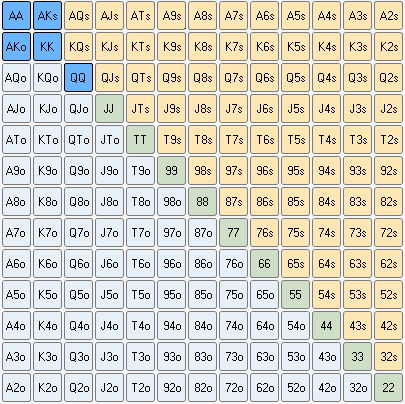Poker is a game of skill, strategy, and probabilities. It’s not just about luck, as many people believe. One of the most important skills to master in poker is understanding poker ranges. In this blog post, we’ll explore what poker card game ranges are, why they’re important, and how you can identify them.
Table of contents
What are Poker Ranges?
A poker range is a set of hands that a player might have in a particular situation. For example, if a player raises from an early position, their range might include hands like pocket pairs, suited connectors, and high-suited cards. If a player limps from a late position, their range might include a wider variety of hands, including speculative hands like suited gappers and offsuit connectors.
Why are Poker Ranges Important?
One of the primary reasons why poker ranges are important is that they help players make informed decisions. By assessing the range of hands that an opponent could have, a player can determine the likelihood of their own hand being the best. For example, if an opponent raises pre-flop, their range is likely to consist of strong hands, such as pocket aces or kings. In contrast, if an opponent limps into the pot, their range could be much wider and may include weaker hands.
Poker ranges also play a critical role in bluffing and determining the likelihood of an opponent’s bluff. By considering the range of hands that an opponent could have, a player can determine whether they are likely to have a strong hand or not. This information can help players decide whether to call a bluff or to make a bluff of their own.
Another reason why poker ranges are important is that they allow players to make more accurate predictions about the future actions of their opponents. By understanding the range of hands that an opponent could have, a player can anticipate how they are likely to act in the future. For example, if an opponent’s range consists of mostly weak hands, they may be more likely to fold if faced with a large bet.
Finally, poker ranges are important because they help players to avoid making costly mistakes. By accurately assessing an opponent’s range, a player can make a more informed decision about whether to bet, call, or fold. This can help players to avoid making costly mistakes, such as calling a large bet with a weak hand or folding a strong hand to a bluff.
Identifying Poker Ranges
Identifying poker ranges is both an art and a science. It requires careful observation and analysis of your opponent’s actions, as well as an understanding of the general ranges that players tend to have in certain situations.
Here are some steps you can take to identify your opponent’s poker range:
- Start with Preflop
The first step in identifying your opponent’s range is to look at their preflop actions. Did they raise, call, or fold? If they were raised, what position were they in? If they called, what position were they in, and what was the size of the bet they called?
By analyzing your opponent’s preflop actions, you can start to get a sense of what hands they might have. For example, if your opponent raised from an early position, their range is likely to be stronger than if they raised from a late position.
- Look at Board Texture
The texture of the flop can also give you clues about your opponent’s range. If the flop is all low cards, for example, your opponent is less likely to have big pocket pairs or high cards in their range. If the flop is all high cards, on the other hand, they may be more likely to have premium hands.
- Consider Betting Patterns
Your opponent’s betting patterns can also give you insight into their range. If they bet big on the flop and turn, for example, they likely have a strong hand. If they check-call all the way down, they may be drawing to a hand or trying to induce a bluff.
- Pay Attention to Showdowns
Finally, paying attention to showdowns can help you narrow down your opponent’s range. If they show down a hand, take note of what they had and how they played it. This can give you clues about what types of hands they’re willing to play aggressively and what types of hands they’re more likely to play passively.
Conclusion
In conclusion, understanding poker ranges is crucial for success in the game. By identifying your opponent’s range, you can make better decisions at the table and adjust your own strategy accordingly. Remember to start with preflop actions, consider board texture, analyze betting patterns, and pay attention to showdowns. With practice, you’ll become a master at identifying poker ranges and taking your poker online or offline game to the next level.


